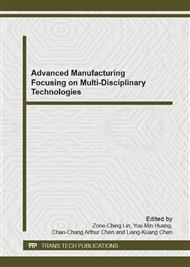[1]
O. Masory, Improving contouring accuracy of NC/CNC systems with additional velocity feedforward loop, ASME J. Engineering for Industry 108 (1986) 227–230.
DOI: 10.1115/1.3187068
Google Scholar
[2]
M. Tomizuka, Zero phase error tracking algorithm for digital control, ASME J. Dyn. Syst. Meas. Control 109 (1987) 65-68.
DOI: 10.1115/1.3143822
Google Scholar
[3]
Y. Koren, Cross-coupled biaxial computer control for manufacturing systems, ASME J. Dyn. Syst. Meas. Control 102 (1980) 265-272.
DOI: 10.1115/1.3149612
Google Scholar
[4]
M.Y. Cheng, K.H. Su, S.F. Wang, Contour error reduction for free-form contour following tasks of biaxial motion control systems, Robot. Comput. -Integr. Manuf. 25 (2) (2009). 323-333.
DOI: 10.1016/j.rcim.2008.01.003
Google Scholar
[5]
M.T. Yan, M.H. Lee, P.L. Yen, Theory and application of a combined self-tuning adaptive control and cross-coupling control in a retrofit milling machine, Mechatron. 15 (2005) 193–211.
DOI: 10.1016/j.mechatronics.2004.07.011
Google Scholar
[6]
S.S. Yeh, Z.H. Tsai, P.L. Hsu, Applications of integrated motion controllers for precise CNC machines, Int. J. Adv. Manuf. Technol. 44 (2009) 906-920.
DOI: 10.1007/s00170-008-1919-1
Google Scholar
[7]
M.C. Tsai, I.F. Chiu, M. Y. Cheng, Design and implementation of command and friction feedforward control for CNC motion controllers, IEE Proc. Control Theory & Applic. 151 (1) (2004) 13-20.
DOI: 10.1049/ip-cta:20040100
Google Scholar
[8]
S. Jee, Y. Koren, A self-organizing fuzzy logic control for friction compensation in feed drives, in Proc. the American Control Conference, Seattle, Washington, (1995) 205-209.
DOI: 10.1109/acc.1995.529238
Google Scholar
[9]
T. Umeno, T. Hori, Robust speed control of DC servomotor using modern two degrees-of-freedom controller design, IEEE Trans. Ind. Electron. 38 (5) (1991) 363-368.
DOI: 10.1109/41.97556
Google Scholar
[10]
H. S. Lee, M. Tomizuka, Robust motion controller design for high-accuracy positioning systems, IEEE Trans. Ind. Electron. 43 (1) (1996) 48-55.
DOI: 10.1109/41.481407
Google Scholar
[11]
M.T. Yan, Y.J. Shiu, Theory and application of a combined feedback–feedforward control and disturbance observer in linear motor drive wire-EDM machines, Int. J. Mach. Tools and Manuf. 48(3-4) (2008) 388-401.
DOI: 10.1016/j.ijmachtools.2007.09.006
Google Scholar
[12]
D. Karnopp, Computer simulation of slip-stick friction in mechanical dynamic systems, ASME J. Dyn. Syst. Meas. Control, 107 (1985) 100-103.
DOI: 10.1115/1.3140698
Google Scholar
[13]
J.C. Wu, K.H. Su, M.Y. Cheng, Friction and disturbance compensation for speed control of servo control systems, in Proc. IECON'10, Nov 07-10, Phoenix, AZ, USA, (2010) 1884-1889.
DOI: 10.1109/iecon.2010.5675379
Google Scholar
[14]
M.C. Tsai, E. C Tseng, M.Y. Cheng, Design of a torque observer for detecting abnormal load, Control Engineering Practice, 8 (2000) 259-269.
DOI: 10.1016/s0967-0661(99)00160-4
Google Scholar
[15]
M.Y. Cheng, C.C. Lee, Motion controller design for contour following tasks based on real-time contour error estimation, IEEE Trans. Ind. Electron. 54 (3) (2007) 1686-1695.
DOI: 10.1109/tie.2007.894691
Google Scholar
[16]
C.T. Johnson, R.D. Lorenz, Experimental identification of friction and its compensation in precise, position controlled mechanisms, IEEE Trans. Ind. Applicat. 28 (1992) 1392-1398.
DOI: 10.1109/28.175293
Google Scholar
[17]
M.Y. Cheng, M.C. Tsai, J.C. Kuo, Real-time NURBS command generators for CNC servo controllers, Int. J. Mach. Tools and Manuf. 42 (7) (2002) 801-813.
DOI: 10.1016/s0890-6955(02)00015-9
Google Scholar


